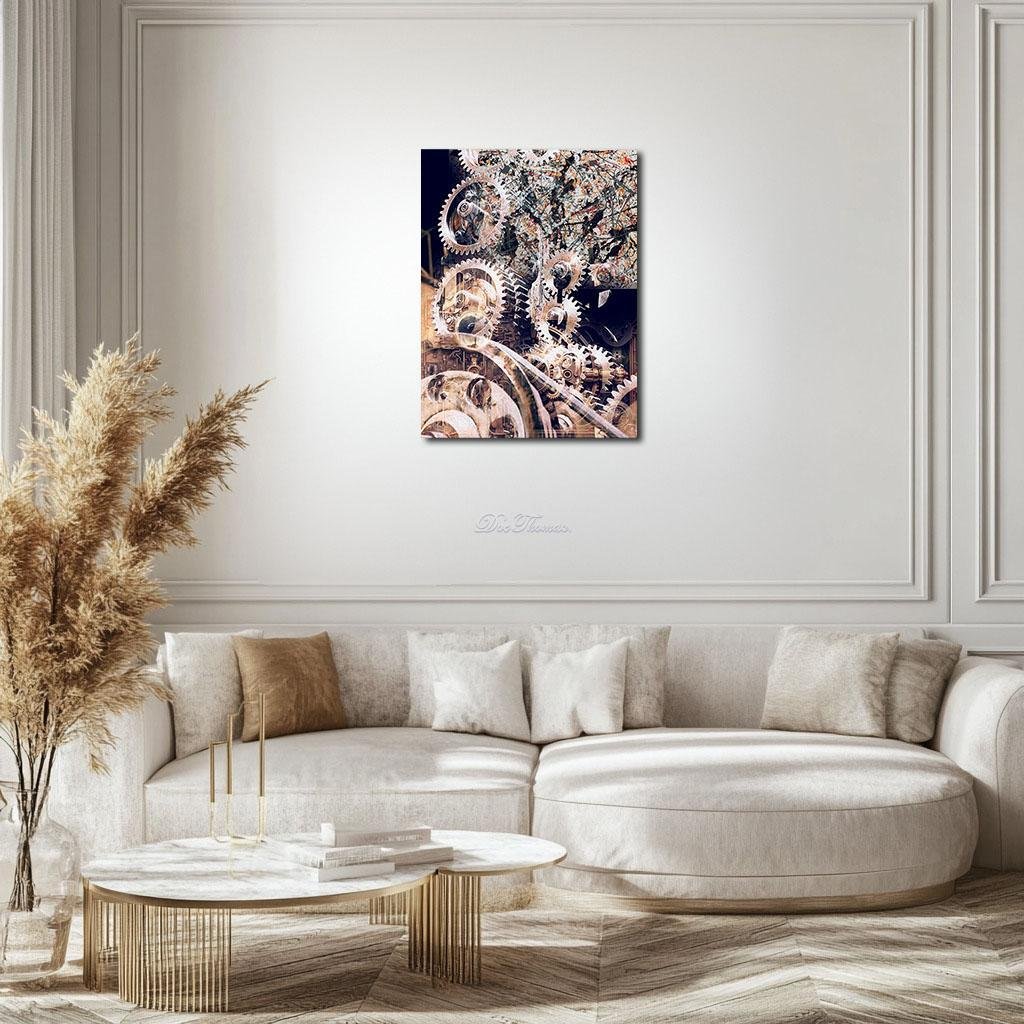Veins of Porcelain: The Machinery of Chaos
Veins of Porcelain: The Machinery of Chaos reframes Pollock’s gestural fury within the glistening anatomy of a machine. His dripping lines and volatile hues are compacted into a quadrant, pulsing atop a sea of interlocking gears. Red becomes ignition. Black becomes blueprint. Below, silver cogs grind emotion into rhythm, but can’t contain it entirely. A single rusted gear interrupts the perfection—a trace of the human beneath the mechanism. In this fusion of chaos and structure, Pollock’s spirit becomes both prisoner and power source—a ghost that keeps the machine alive.
Please see Below for Details…
Hotline Order:
Mon - Fri: 07AM - 06PM
404-872-4663
Veins of Porcelain: The Machinery of Chaos transforms Jackson Pollock’s unmistakable painterly language into a meditation on the conflict between automation and instinct, rhythm and rupture. Here, his visceral energy is not isolated on canvas—it is trapped, funneled, and spun within a network of glistening metallic gears, pulleys, and cogwheels. This reinterpretation envisions Pollock’s signature chaos as the soul of a mechanical heart, revealing what happens when raw emotion is forced into systems, when the irrational is threaded through the cold elegance of machinery.
At the top right, Pollock’s original painting pulses like a nerve—its spatters and streams colliding in a feverish constellation of reds, blacks, ochres, and steely gray. Unlike its original open-field presence, here it is compacted into a quadrant, framed like a code to be read by the great machine beneath. The black lines carve through space with the sharpness of incised steel. The reds erupt like tiny fuel ignitions. Blue traces cool the scene, while bursts of white flash like warning signals. There’s no longer a pure organic feel—Pollock’s canvas now pulses with the stutter of industrial breath.
Beneath this, a labyrinth of clockwork takes over. Gleaming gears in silver, brass, and iron spiral through the composition, some larger than life, others intricate and spider-like. They seem to consume the space around them, compressing Pollock’s painting into fuel—rotating and winding and spitting it back out in fragmented repetition. This isn’t merely an aesthetic contrast; it’s a philosophical one. Here, spontaneity becomes engine. Emotion becomes architecture. Chaos becomes rhythm.
Color plays a critical narrative role in this transformation. The top quadrant, dominated by Pollock’s palette, bristles with heat and nervous energy. The dominant black—a Pollock hallmark—slices through the scene like a blueprint in distress. Around it, crimsons flicker with warning, while earthy yellows and muted gray-greens invoke a burnt forest, a disintegrating map. The gearworks below counterbalance with a cooler spectrum: chrome silvers, iron blues, and soft, oily copper. Light reflects off each cog like a calculated memory, cold and impersonal. This opposition—warm chaos above, cold order below—becomes the essential tension of the work.
As an artist, my thought while shaping this reinterpretation was to explore the idea of what happens when expression is mechanized. Pollock painted with his entire body—his rhythm was jazz, instinct, breath. His canvas was a battlefield of immediacy. What happens, then, when that same energy is filtered through the systems we now live by—automated schedules, algorithmic culture, artificial productivity?
The gears do not rebel. They perform. And in that performance, the Pollock within them doesn’t vanish—it changes. It mutates. It becomes ghost and fuel, turning emotional labor into literal labor. There’s beauty in their symmetry, yes. But there’s also loss. The loss of human gesture, of breath caught mid-stroke, of the painting as a field of meditation rather than a circuit to be completed.
And yet, this isn’t a condemnation. Veins of Porcelain: The Machinery of Chaos is not about destruction—it’s about transformation. The chaos doesn’t die here. It adapts. Pollock’s lines do not stop at the edge of the canvas; they bleed into the gears, become sinew for the mechanical beast. The system becomes haunted by its source.
At the visual heart of the machine lies a broken gear—rusted and static. It’s subtle, tucked among the perfect circles, but crucial. It’s the reminder that no system can fully contain the chaos it attempts to regulate. Pollock’s paint drips not in submission, but in infiltration. The broken gear is the return of error, the place where rhythm skips and breath enters again.
Veins of Porcelain: The Machinery of Chaos is a study in tension, but also in harmony. It suggests that within even the most cold and calibrated spaces, the artist persists. That every gear turning is haunted by a brushstroke, every system echoing a scream. It is the unseen dialogue between the human and the mechanical—between Pollock and the post-industrial dream.
Add your review
Your email address will not be published. Required fields are marked *
Please login to write review!
Looks like there are no reviews yet.








